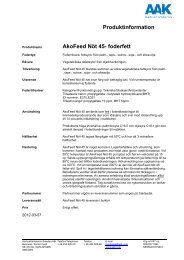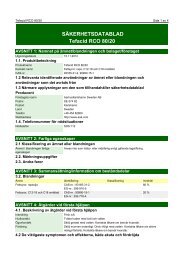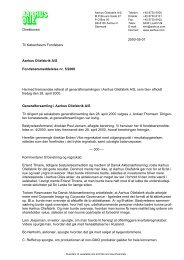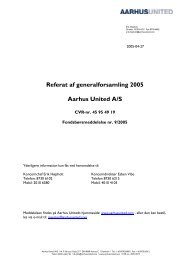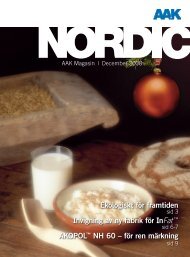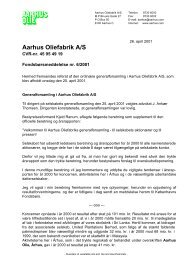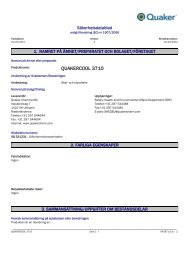Beat Migration Bloom on Chocolate Products by Optimizing ... - AAK
Beat Migration Bloom on Chocolate Products by Optimizing ... - AAK
Beat Migration Bloom on Chocolate Products by Optimizing ... - AAK
You also want an ePaper? Increase the reach of your titles
YUMPU automatically turns print PDFs into web optimized ePapers that Google loves.
<str<strong>on</strong>g>Beat</str<strong>on</strong>g> <str<strong>on</strong>g>Migrati<strong>on</strong></str<strong>on</strong>g> <str<strong>on</strong>g>Bloom</str<strong>on</strong>g> <strong>by</strong> <strong>Optimizing</strong> Your Process<br />
Heat treatment at<br />
28°C for <strong>on</strong>e week<br />
purifies the<br />
polymorphism and<br />
at the same time<br />
inhibits visual<br />
bloom development<br />
for 12 m<strong>on</strong>ths<br />
despite the<br />
oil migrati<strong>on</strong>.<br />
Dsc performed <strong>on</strong> the chocolate at a distance<br />
of 0.5mm from the nuts shows a 0.6°C higher<br />
melting peak value in the chocolate which is<br />
heat treated at 28°C compared with the 20°C<br />
“heat-treated” chocolate, and exactly the same<br />
difference is found 10mm from a nut surface<br />
for both.<br />
It seems that heat treatment at 28°C for <strong>on</strong>e<br />
week purifies the polymorphism and at the<br />
same time inhibits visual bloom development<br />
for 12 m<strong>on</strong>ths despite the oil migrati<strong>on</strong>. This<br />
suggests that either the tempering or the cool-<br />
ing or both favored Form IV crystallizati<strong>on</strong> that<br />
was expressed as bloom in the n<strong>on</strong>-heat-treat-<br />
ed samples.<br />
It shows how important it is to c<strong>on</strong>trol crystal<br />
development and ensure crystal stability to re-<br />
tard bloom development.<br />
A theory could be that if this transformati<strong>on</strong><br />
happens fully above the solidificati<strong>on</strong> point of<br />
Form IV for this chocolate’s particular TAG com-<br />
positi<strong>on</strong>, no visual bloom is developed and all<br />
Form IV crystals are moved to Form V without<br />
bloom development. However, if this transfor-<br />
mati<strong>on</strong> happens at a lower temperature, below<br />
the Form IV solidificati<strong>on</strong> temperature, larger<br />
bloom crystals will appear.<br />
One week at 28°C has speeded up the mi-<br />
grati<strong>on</strong> to an equilibrium state and no essential<br />
Form IV-to-V transformati<strong>on</strong>s happen after the<br />
<strong>on</strong>e week and therefore no bloom develops.<br />
Of course, bloom will reappear when the<br />
Form V-to-VI transformati<strong>on</strong> starts, but that<br />
takes much l<strong>on</strong>ger and is therefore not the big-<br />
gest problem for producers of filled products.<br />
The above theory explains the results from<br />
Results from Heat-treated Filled Praline Bars<br />
6 May 2010 • Reprint from The Manufacturing C<strong>on</strong>fecti<strong>on</strong>er<br />
a real producti<strong>on</strong> line (Figure 9), which is <strong>on</strong>e<br />
example am<strong>on</strong>g many.<br />
The applicati<strong>on</strong> is a standard praline bar<br />
with a soft “bloom-critical” filling inside and a<br />
dark chocolate shell.All the praline bars were<br />
produced <strong>on</strong>e week before the test was start-<br />
ed and all pralines were glossy and free from<br />
any bloom. The pralines were divided into two<br />
batches and unwrapped.<br />
• Reference batch is kept for 24 h at 20°C be-<br />
fore it is stored in 15°C and 23°C isothermal<br />
bloom test cabinets<br />
• Test batch is kept for 24 h at 25°C before it<br />
is stored in 15°C and 23°C isothermal bloom<br />
test cabinets<br />
Other examples are tests made where some<br />
FrozenC<strong>on</strong>e (FCT) shells are heat treated be-<br />
fore the filling is deposited.<br />
Some dark praline shells are made <strong>on</strong> FCT<br />
pilot equipment. Cooling is 3 sec<strong>on</strong>ds at 15°C<br />
and the shell thickness is 1.5mm.Afterwards all<br />
shells are cooled for 20 minutes at 12°C and<br />
then divided into two batches.<br />
Batch 1, reference<br />
• Shells are filled with a nougat filling with high<br />
amounts of hazelnut paste<br />
• Cooled for 15 min at 12°C<br />
• Backed off and then cooled at 12°C for 30<br />
min.<br />
Batch 2, test samples<br />
• Shells are stored for 30 min at 30°C<br />
• Filled with nougat filling with high amounts of<br />
hazelnut paste<br />
• Cooled for 15 min at 12°C<br />
• Backed off and then cooled at 12°C for 30<br />
Batch 1, Reference Batch 2, Test Samples<br />
20°C for 24 hrs 25°C for 24 hrs<br />
15°C isothermal cabinet 7 weeks, str<strong>on</strong>g bloom > 25 weeks, no bloom<br />
23°C isothermal cabinet 9 weeks, str<strong>on</strong>g bloom > 25 weeks, no bloom<br />
Figure 9<br />
min






